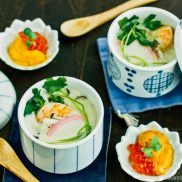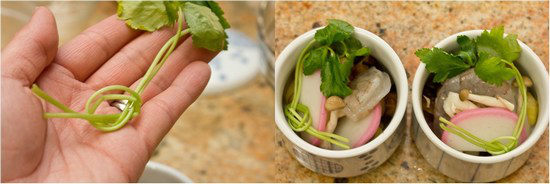
Chawanmushi (茶碗蒸し) is a savory egg custard dish which served as an appetizer in Japanese restaurants. It literary means ‘steamed in a tea bowl/cup’. Chawan in Japanese means tea bowl or bowl, and -Mushi means steamed.

Typically Chawanmushi includes ginkgo nuts, shiitake mushrooms, kamaboko fish cake and filled with an egg mixture that is flavored with dashi, soy sauce, and mirin.

I often put shrimp in Chawanmushi as it looks pretty when shrimp’s orange/red color peeks from top of the egg custard. My signature recipe for this dish includes ikura (salmon roe) and uni (sea urchin) on top of the Chawanmushi. It’s our favorite way to eat Chawanmushi and I hope you give it a try!

I hope you will enjoy making this Chawanmushi with shrimp recipe! If you try it, don’t forget to share your picture on Instagram, Facebook, or Twitter with #JustOneCookbook. Thank you so much for reading, and till next time!
Wish to learn more about Japanese cooking? Sign up for our free newsletter to receive cooking tips & recipe updates! And stay in touch with me on Facebook, Pinterest, YouTube, and Instagram.

Chawanmushi with Shrimp
Ingredients
- 2 dried shiitake mushrooms
- 3 Tbsp water (for hydrating the dried shiitake)
- ½ boneless, skinless chicken thigh (cut into small pieces; soak in 1 Tbsp sake to get rid of the unwanted smell)
- 4 shrimp (peeled and deveined; soaked in 1 Tbsp sake to get rid of the unwanted smell)
- 4 sprigs mitsuba (Japanese parsley) (or you can use scallion/green onion)
- 4 ginkgo nuts (pre-cooked; optional)
- ½ package shimeji mushrooms (1.8 oz, 50 g; bottom ends removed; separated into small clusters)
- 4 slices kamaboko (fish cake)
For the Egg Custard Mixture
- 1 large egg (50 g each w/o shell)
- ½ tsp mirin
- ½ tsp usukuchi (light-colored) soy sauce (I use light-colored soy sauce so the egg mixture will not become too dark)
- ¼ tsp Diamond Crystal kosher salt
- ½ cup dashi (Japanese soup stock) (use standard Awase Dashi, dashi packet or powder, or Vegan Dashi)
For the Toppings (optional)
- 2 pieces uni (sea urchin)
- 2 Tbsp ikura (salmon roe)
Instructions
- Gather all the ingredients. Feel free to replace the ingredients with any seasonal ingredients.

To Prepare the Ingredients
- In a small bowl, put 2 dried shiitake mushrooms and 3 Tbsp water and rehydrate for 15 minutes. When the shiitake becomes soft, squeeze the water out and slice them thinly. Tip: This liquid is shiitake dashi that you can use as a part of your ½ cup dashi (Japanese soup stock) in this recipe. To do that, strain the shiitake stock (to remove any impurities), and add more dashi until you get ½ cup total.

- Make a knot in each stem of 4 sprigs mitsuba (Japanese parsley), if you are using it. Divide all the ingredients into the individual cups. I start with small pieces of ½ boneless, skinless chicken thigh, the sliced shiitake, 4 ginkgo nuts, and ½ package shimeji mushrooms. Then, put 4 slices kamaboko (fish cake), 4 shrimp, and the mitsuba on top (the colorful ingredients should be at the top).

To Make the Egg Custard Mixture
- Whisk 1 large egg (50 g each w/o shell) in a medium bowl. Add ½ tsp mirin, ½ tsp usukuchi (light-colored) soy sauce, ¼ tsp Diamond Crystal kosher salt, and ½ cup dashi (Japanese soup stock). Mix well together.

- Then, strain the mixture through a fine-mesh sieve into another bowl. This helps making a silky texture.

- Pour the egg custard mixture into the prepared cups. Instead of covering the ingredients completely with egg, leave some ingredients exposed so chawanmushi will look nice. Remove any air bubbles with a spoon or bamboo skewer. Put the chawanmushi lids on (or tightly cover with foil).

To Cook the Chawanmushi
- Prepare a pot and lid that fits your chawanmushi cups. Add enough water to the pot to go halfway up the chawanmushi cups (but don‘t add the cups to the pot yet). Bring the water to a boil, then reduce the heat to the LOWEST setting. Gently place the chawanmushi cups inside the hot water (it should not be boiling) and cover the pot with the lid. Cook for 25–30 minutes on the lowest heat. If you are not adding shrimp and/or chicken, the cooking time should only be 15–20 minutes. Insert a skewer in the center of the custard to see if the egg is done. If clear liquid comes out, it‘s done.

To Serve
- Serve warm with 2 pieces uni (sea urchin) and 2 Tbsp ikura (salmon roe) on the side (optional). Place one of each on top of the chawanmushi right before you eat.

To Store
- You can keep the leftovers in a chawanmushi cup and store in the refrigerator for up to 2 days. To reheat, steam for 2 minutes.








Hello! Can I steam this in one big bowl, instead of small ramekins? 🙂
Hi Cha! Thank you for taking the time to read Nami’s post and try her recipe!
In general, this dish is served in small portions. However, you may steam this in a large bowl. The cooking time may need to be changed according to the size.
We hope you like the Chawanmushi!
Just made this for the first time and it was delicious!!! It was still super runny though (not that firm) even though i cooked it more than 45 minutes. What do you think I’m doing wrong?
Hi Irene, We are glad to hear you enjoyed the Chawanmushi!
When egg and Dashi are separated, Chawanmushi is ready to enjoy. It should not be too firm. When you insert a skewer in the center of the custard, the clear liquid should come out. So we think your Chawanmushi was done perfectly.
We hope this helps.
Made this 2 times, can’t get enough! So so so good!
Hi K, We are so glad to hear you enjoyed this Chawanmushi! Thank you very much for trying this recipe and for your kind feedback.
So far I have only used fresh shitake mushroom to add to my steamed egg because I thought they get cooked faster and hence more suitable for steamed eggs. Which would taste better in steamed eggs? dried or fresh shitake mushooms?
thank you again!
Hi! Dried shiitake mushrooms definitely have more flavor when you’re comparing specifically the flavor. Same thing for fresh herbs vs dried one. Dried ones are more powerful and you need more fresh herbs to have the same effect. 🙂
I could not find a video to accompany this recipe for Chawanmushi.I am very frustrated&sad/disappointed 🙃.please include them when you post recipes.If there is no video I have no reason to buy the cookbook or receive your email because the techniques described in a recipe are cold and do not show what you mean.If I can make a dish well I will keep the recipe&explore more recipes from the book.That is fun&does not waste food,time,or money.
Hi LJ! Unfortunately, I don’t get to make a video for each recipe as filming takes a long time to produce and I want to publish more recipes on the website. Most websites do not provide step by step images but I do offer to compromise, even though it takes time to take pictures every step of the cooking. I hope you understand. My priority is always the website with some videos, and I’m not a YouTuber without running a website. Luckily, there are a lot of Japanese recipe videos on YouTube you can explore. 🙂
Hi LJ! It’s too bad that you must move on, but your loss is also our gain. Without your negativity we will all enjoy our gracious host’s knowledge and sacrifices even more. I loved this recipe and was able to make it by reading her complete and thoughtful recipe without a video to reinforce the obvious. Best of luck to you!
Hi Michael! Thanks so much for your kind words, and I’m so glad my recipes help you achieve a good result! If you have any question, please let us know. We’ll be happy to help! xo
Hi Nami, What do you often serve chawanmushi with? Is it considered a side dish? It seems ambiguous! Is it too much to serve it with rice and soup or rice and a simple broiled fish? Or is this a sort of breakfast by itself? Thank you so much!
Hi Nana! Typical chanwanmushi cups are the one you see in my pictures – small, like Japanese tea cup size. We serve it as an appetizer or side dish. Not a main dish, typically. BUT every home cook can make their own way. You can use a big bowl to make chawanmushi and treat it like a main dish. However, you can take so much of the egg mixture, so unless you are a huge fan of egg custard food, I think it’s best served as a side dish. As this is more traditional dish, a broiled fish would be great for a main meal. 🙂
Ahhhh,, I remember how I used to love New Years celebration because I knew my mother’s friend would always make Chawanmushi! I loved the ginkyo nuts the best, and she would always put extra in mine. Thanks for the recipe!
Hi Mary! I hope you enjoy making this at home. It takes a bit of time and effort to make really good chawanmushi, but the result is always worth it. 🙂
Hi Nami
If i will like to have 20 servings of chawamushi, how should i increase the ingredients?
Thanks.
Cheers
EG
Hi Esther! It is a bit tedious but you just need to multiply this recipe by 10. I usually make 4-6 by simply multiplying and it works. By the way, the steaming 20 cups is probably the most difficult part, especially if you want to serve at the same time. Chawanmushi is usually too hot to eat right after cooking, so you don’t necessarily need to serve “right away”. But still, it tastes good when it’s warm. Good luck!
hi esther, my grandmother would make this every new years eve, and we always would have a large family gathering. what she would do is put the cups, covered, in a deep oven pan (like a casserole dish) and fill the pan until it covers the cups halfway, and then put it into the oven. i’m not sure what temperature it would be, but i would think just above steaming (so maybe 225 F or so?). if you have a double oven, you could easily make 20 at a time!
i tried this recipe a few months ago, and it was perfect! it made me a little emotional eating it by myself, because my grandmother passed around 5 years ago and our family hasn’t had it since. it tasted exactly as i remembered. right now isn’t a very good time to get high quality uni unfortunately (most of the seafood in my area is a little bad because of covid19 wait times) but i really want to try the uni and ikura version! seems very luxurious!
Hi Chris,
Wow! What a great idea! Thank you for sharing your grandmother’s technic with us!
And thank you for trying Nami’s recipe and for your kind feedback. We are so glad to hear you enjoyed this recipe.
Yes! Please try it with Uni and Ikura. It’s soooo good and levels up the Chawanmushi!
Have a nice Holiday.☺️